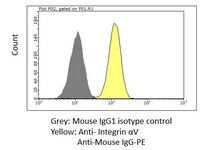MAB1978-I-25UL Sigma-AldrichAnti-Integrin αV Antibody, clone LM142
Anti-Integrin aV, clone LM142, Cat. No. MAB1978-I, is a mouse monoclonal antibody that detects Integrin aV and is used in Affinity Binding Assay, Flow Cytometry, Immunocytochemistry, Immunofluorescence, Immunoprecipitation, and Surface plasmon resonance.
More>> Anti-Integrin aV, clone LM142, Cat. No. MAB1978-I, is a mouse monoclonal antibody that detects Integrin aV and is used in Affinity Binding Assay, Flow Cytometry, Immunocytochemistry, Immunofluorescence, Immunoprecipitation, and Surface plasmon resonance. Less<<Produits recommandés
Aperçu
| Replacement Information |
|---|
| References |
|---|
| Product Information | |
|---|---|
| Format | Purified |
| Presentation | Purified mouse monoclonal antibody IgG1 in buffer containing 0.1 M Tris-Glycine (pH 7.4), 150 mM NaCl with 0.05% sodium azide. |
| Quality Level | MQ200 |
| Physicochemical Information |
|---|
| Dimensions |
|---|
| Materials Information |
|---|
| Toxicological Information |
|---|
| Safety Information according to GHS |
|---|
| Safety Information |
|---|
| Storage and Shipping Information | |
|---|---|
| Storage Conditions | Recommend storage at +2°C to +8°C. For long term storage antibodies can be kept at -20°C. Avoid repeated freeze-thaws. |
| Packaging Information | |
|---|---|
| Material Size | 25 µL |
| Transport Information |
|---|
| Supplemental Information |
|---|
| Specifications |
|---|
| Global Trade Item Number | |
|---|---|
| Référence | GTIN |
| MAB1978-I-25UL | 04065266553949 |
Documentation
Anti-Integrin αV Antibody, clone LM142 FDS
| Titre |
|---|
Anti-Integrin αV Antibody, clone LM142 Certificats d'analyse
| Titre | Numéro de lot |
|---|---|
| Anti-Integrin αV, clone LM142 - Q3702361 | Q3702361 |








